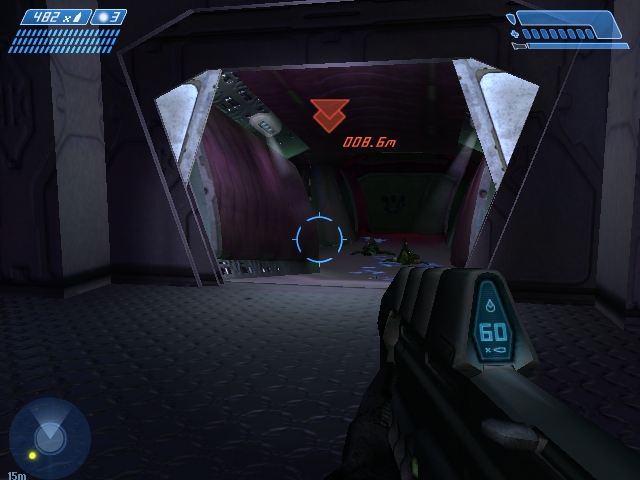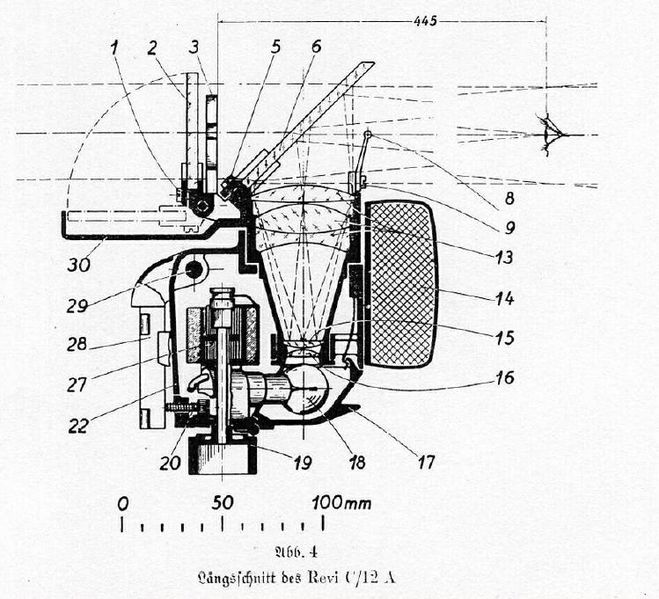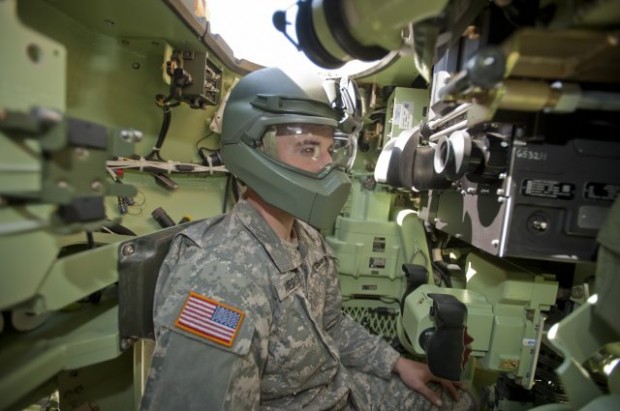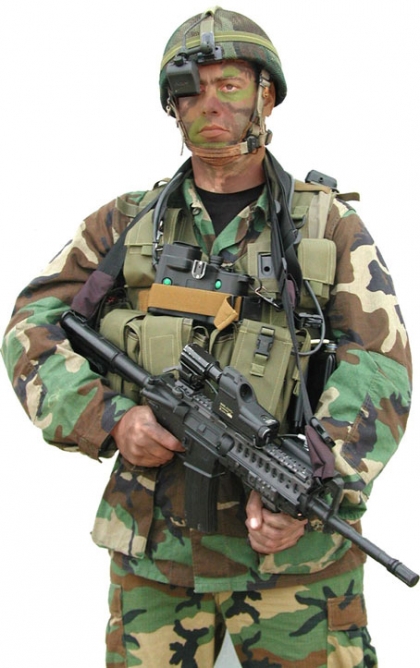We all seen this type of technology in Halo for nearly a decade and a half. This technology does exist today, albeit in a slightly different form.
Disclaimer: I am not an expert in this field. This article was in part written and reflagged from existing articles that I’ve included references for near the end of the article. Any facts I may get wrong are not intentional. This article is for entertainment purposes only and is by no means exhaustive with the information herein. I highly suggest you click on the links contained throughout the article if you want to get a fuller understanding of this real-world tech.
Fiction
In Halo, we the gamers use the heads up display for motion tracking, ammo and grenade counts as well as health, shields and targeting. As with all technology, the HUD has changed from Halo CE through to Halo 4.
Halo CE’s HUD
Halo 2’s HUD
Halo 3’s HUD
Halo 4’s HUD
The HUD in Halo can also detect what weapon the bearer has in their hands, switching targeting reticles to match that of the weapon in use. The term HUD is actually incorrect and should be call HMD or helmet mounted display. The difference being that in HUDs you have to look up to see it and it’s fixed into place. Whereas, the HMD is shown on the visor and thus moves with the user’s head movement.
Fact
Since Halo CE, we gamers have enjoyed the use of a heads up display or HUD. The technology shown in the game from the start up to the present game for a singular soldier on the battlefield was something that only a decade ago was science fiction.
The earliest for a HUD tech can be traced back to pre-Wolrd War II. HUD tech evolved from “reflector sight,” a parallax free optical sight tech for military jet fighters. Below shows an early German schematic of this tech.
 Gyro gunsight was the first tech to use reflector sight. As this tech advanced, the early HUDs started displaying computed gunnery solutions. An example of this is the British AI Mk VIII air interception radar. The radar display was projected onto an aircrafts windscreen also showing an artificial horizon. This allowed pilots to now dogfight without having to look away from their windscreen to check their radar.
Gyro gunsight was the first tech to use reflector sight. As this tech advanced, the early HUDs started displaying computed gunnery solutions. An example of this is the British AI Mk VIII air interception radar. The radar display was projected onto an aircrafts windscreen also showing an artificial horizon. This allowed pilots to now dogfight without having to look away from their windscreen to check their radar.
HUD tech evolved in 1958 by the Royal Navy. This HUD had an attack sight that provided nav and weapon release info for low level attacks. This HUD tech faced strong competition from those who supported the older electro-mechanical gunsight. In the ’60s French test-pilot Gilbert Klopfstien created the first modern HUD and a standardized set of symbols for HUDs so pilots only needed to learn one system. The ’70s brought HUD tech to commercial aviation. In 1988 the Oldsmobile Cutlass Supreme was the first car to have a HUD. (1)
HUD tech for soldiers’ helmets have been around for a few years now. In 2004 at the Soldier Technology (convention) in Belgium, a new system for the time was shown. It was the NA-OR Advanced Integrated Soldier System or AISS. This personal HUD improved situational awareness, target identifcation, bidirectional communication of data and an early “Friend or Foe” tag system. An example of this HUD is shown below on the soldier’s helmet. (2)
Fast forward to 2013 where HUD tech is now not only looking like the HALO HUD on a small screen, but is now incorporated into a full face visor on a helmet that looks VERY much like an early Spartan Helmet.
Just last year, Sept. 2013, this new tech was shown at the Association of the U.S. Army’s annual meeting. The helmet not only has enhanced protective measures, but also embedded technology that includes a see-through, heads-up display and communication capabilities.
With 72 percent of all combat injuries impacting the face, the engineers sought to bridge a “technology gap” with a mandible and visor on the helmet.
The helmet includes cushioning to meet a 14-feet-per-second impact requirement, which will help reduce cases of traumatic brain injuries that translates to protection for a rifle round threat. (3)
This Halo-like helmet has not yet been adopted into the military yet.
Take a look at these videos by Revision Military, the makers of the above helmet:
https://www.youtube.com/watch?v=TFFtCU7tcsI
https://www.youtube.com/watch?v=tQKV43WAx_c
With the advent of Google Glass and the developing bionic contact lens, people from all over the globe will be able to have personal heads up display. The new Augmented-reality contact lens is touted to be “human-ready” at this year’s CES (Consumer Electronics Show).
1. http://en.wikipedia.org/wiki/Head-up_display
2. http://www.gizmag.com/go/3042/
3. http://www.theblaze.com/stories/2013/10/25/the-armys-futuristic-halo-like-helmet-that-can-take-a-14-feet-per-second-impact/
While the HUD of the present as yet can not detect what weapon the soldier is currently holding, can that tech really be far behind? Bio-scan technology is being integrated into current HUDs to alert the soldier as well as their base of the vital signs.
Summary
The HUD of Halo isn’t science fiction anymore. While current tech does not yet include all of the aspects of Halo’s HUD, it most certainly is close. It’s very predictable that in the very near future, current technology will have the rest of Halo’s HUD incorporated into single soldier use.
Did you enjoy this article? I’d like to know what you think of it and the tech talked about within. Please hit reply below and share your thoughts.
-Sal



Sal I love reading these articles, keep them up. They are very interesting and help enlighten the fact that Halo has influenced future technologies to be attempted and hopefully made a reality.
I love what you do with these.
I have to agree with Thomas, as I too find these articles downright interesting. I had no idea we had some of this technology or the know how to make it a reality.
Another great article Sal. Keep em coming! Here is another link that might be of interest on Helmet Mounted Displays.
https://www.youtube.com/watch?v=DQkm8oLPb4c
This one is on the helmet for the F-35 Joint Strike Fighter. As it states in the video, this helmet ties into a system of cameras distributed around the airplane and allows the pilot to look through the structure of the plane as well as seeing all his flight information. It also is able to cue weapon systems so all the pilot has to do is look at a target and the targeting system will “lock on”. It does have some issues though. There is supposed to be problems with image jitter in certain conditions (probably high G forces and buffeting) and (like most things on the F-35) is over budget and behind schedule.
Love these articles Sal, its very interesting to see how close we are with some of the tech. I imagine individual weapon recognition/linking isn’t too far behind. If they can link the cannon of the AH-64 Apache to follow where the gunner looks, I imagine linking a HMD to a rifle scope isn’t too big of a leap.
I really enjoyed this article. There has been a push for some time to bring technology like this down to the individual soldier. Most soldiers are taught how to use Night Vision Goggles (promethian vision anyone?) but that is as far as it goes for a number of reasons but cost more than anything.
I hope you keep these articles going. I always enjoy them!
Thanks, I’m glad you enjoy them. I will indeed keep them going. I already have 3 topics ready to write about.